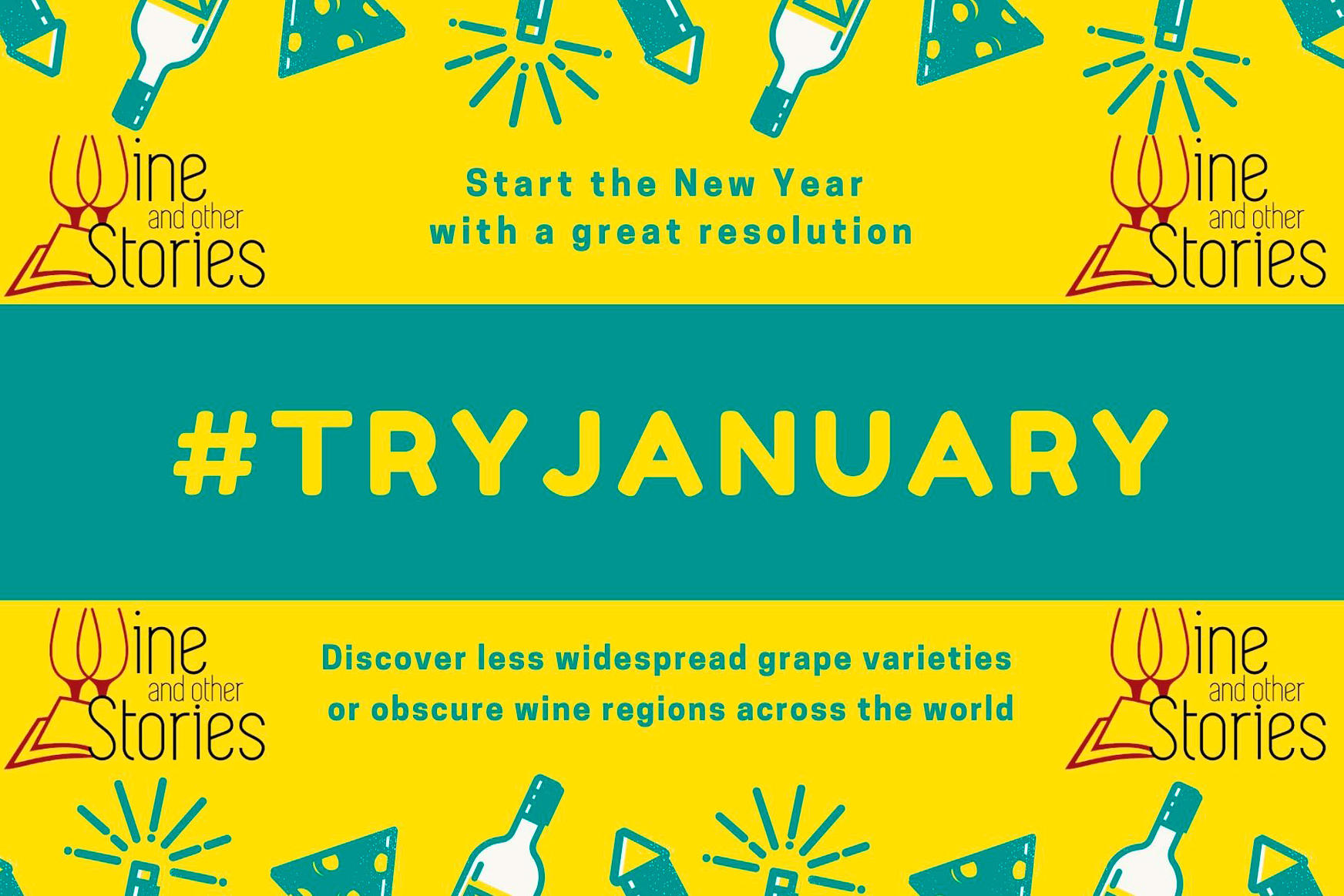Willing to discover new grape varieties and unveil off-the-beaten-track wine regions? Give #TryJanuary a go! My contribution to the initiative envisions a white and a red wine, both from Italy. A falanghina from Campania and a humagne rouge from Aosta Valley
Since the introduction of the Gregorian Calendar, January has been the first month of the year. January is named after Janus, the ancient Roman god of transitions, passages, time and duality. Unsurprisingly, Janus is always portrayed as having two faces. After all, he looks at the past and the future at the same time.
January, the first month of the year, shares the same fate. It’s a peculiar month, a period of new propositions and self-reflection. We are obviously the same as a few days earlier, but simultaneously we are somehow different as we enter the New Year. I find it curious that every time our Earth completes its perfect elliptical orbit around its star, people feel the need to reassess their lives and existential goals. I admit I’m often influenced by this phenomenon and end up formulating new resolutions for the year ahead.

There are different sorts of resolutions, and I have to confess I find some of them irritating. Perhaps one stands over the others: Dry January. People mercilessly show off their intent on social media. You have probably already noticed the proliferation of the #DryJanuary hashtag.
A recent article by Amber LeBeau called “Dry January can go to hell” admirably sums up all the reasons I dislike Dry January. I agree with Amber line by line (like her, I definitively advocate moderation), so check out her article, as I hate repetition.
Forget about Dry January, embrace #TryJanuary
Some people (including Amber) proposed a #TryJanuary proposition instead, which I personally find way more interesting and uplifting. The idea behind #TryJanuary is to discover less widespread grape varieties or obscure wine regions. I encourage you to pursue #TryJanuary, as a way to broaden your vinous horizons. You will uncover new favourites or find new wine travel destinations.
Subconsciously, I had been preparing for the #TryJanuary challenge for a while. In December I decided to explore new Italian wine regions that are overlooked in the UK. Taking advantage of my time spent in Italy for the Christmas break, I purchased a number of wines from obscure local grapes and Italian regions that are largely ignored by the UK’s wine large distribution.
Throughout January, I will share my discoveries and publish reviews of unsung grape varieties or bottles coming from wine regions that are off the beaten track. Spoiler alert: all the wines will be Italian! This is my personal tribute to the #TryJanuary initiative. So don’t expect any Chianti or Barolo. Alas, a couple of these wines are difficult to find outside Italy. Others are not mainstream, but you can still buy them if you work hard enough. A two for one adventure. Even better, you can plan your next trip to Italy to visit these wine regions!
Let’s start with two wines for my Italian themed #TryJanuary: “Serrocielo” Falanghina del Sannio by Feudi di San Gregorio and “Vigne Rovettaz” Cornalin by Grosjean.
“Serrocielo” Falanghina del Sannio by Feudi di San Gregorio
Falanghina is the forgotten white grape of Campania. It might not have the same charisma of Campania’s leading white grapes (fiano and greco), but Falanghina can produce great wines.

Falanghina has a noble ancestry. It is thought to be of Greek origin and some historians believe it’s the grape variety behind the Falernian, the most renowned wine among ancient Romans. Today, falanghina is experiencing a comeback. Some wine critics and connoisseurs are starting to notice the grape outside Italy. Its lively acidity and intriguing mineral notes make falanghina a food-friendly wine. The grape is quite eclectic in nature too, as it changes to express the local terroir. Take this “Serrocielo” falanghina for example. It’s produced in the Sannio area, inland in the Campania region. The signature of this sub-zone is a striking minerality and a balsamic – almost resinous – character. All of which is perfectly expressed in this wine.
Feudi di San Gregorio - Serrocielo Falanghina del Sannio, 2017

 Country: Italy
Region/appellation: Campania - Falanghina del Sannio DOC
Wine style: Dry white - Tropical and Balanced
Grape(s): Falanghina
Average price: £13
Country: Italy
Region/appellation: Campania - Falanghina del Sannio DOC
Wine style: Dry white - Tropical and Balanced
Grape(s): Falanghina
Average price: £13
Feudi di San Gregorio has a stellar reputation as one of Campania’s leading wine producers. Its founders, Enzo Ercolino and Mirella Capaldo, established the estate in 1986. The winery is located in Sorbo Serpico, a tiny village in Irpinia, the mountainous inland of the region.
The wine producer’s name is inspired by Saint Peter of the Gregorian age, whose heritage extended throughout the whole area of Irpinia and Sannio. The land has been cultivated since the 6th century, and Feudi di San Gregorio honours the place’s rich history. Their vineyards (some more one hundred years old) have ancient local grape varieties planted such as aglianico, fiano, greco and falanghina.
“Serrocielo” comes from the best falanghina grapes of Feudi di San Gregorio. After fermentation, the wine is matured in stainless steel tanks for 6 months with lees contact and constant batonnage to thicken the body and confer a richer texture.
Tasting notes
(tasted on: 23-Jan-2019)
The wine has a straw/lemon hue in the glass, appearing translucent and brilliant. On the nose, the rich aromatic profile contains notes of juicy grapefruit, Seville orange, nectarine and even a suggestion of passion fruit. All traversed by a saline minerality and lovely nuances of jasmine and lemon blossoms.
On the palate, the mouthful is dense but lively. The wine is full bodied yet still joyful, thanks to a crisp acidity that enhances this white’s drinkability. The fleshy fruity notes mirror the nose. An iodine minerality emerges in the mid-palate, along with hints of orange zest, pine resin and wet stone. Good intensity and balance. If you ask me, a heavenly pairing for the “Serrocielo” falanghina is a creamy stracciatella from Puglia. Alternatively, match this wine with caprese salad, fried fish and even red meat… Each time the white will stand up splendidly.
Wine and other Stories rating: 8.8/10
“Vigne Rovettaz” Cornalin by Grosjean
This wine originates from Aosta Valley located in the Graian Alps of the northwest of Italy. It is Italy’s smallest region. Nestled between Piemonte, France and Switzerland, Aosta Valley is clearly influenced by its neighbours – both in its traditions and wine. French is Aosta’s official second language. The most widespread grape varieties are nebbiolo (known locally as picotendro), chardonnay, gamay, petit rouge and fumin.
The region’s viticulture features the same heroic character of other Alpine wine districts. Production is limited and working the land is often a challenge. But the best wines bestowed by these mountainous areas are wholly rewarding. Altitude and high diurnal excursions give the wines a crisp acidity and precise flavours. Both characteristics expressed by “Vigne Rovettaz” Cornalin, this week’s red wine for #TryJanuary. The wine is entirely made from humagne rouge (also known as cornalin d’Aoste), a grape that only grows in Aosta Valley and Switzerland.
Grosjean - Vigne Rovettaz Cornalin, 2016

 Country: Italy
Region/appellation: Valle d'Aosta - Vallée d'Aoste DOC
Wine style: Dry red - Savoury and classic
Grape(s): Humagne Rouge
Average price: £17
Country: Italy
Region/appellation: Valle d'Aosta - Vallée d'Aoste DOC
Wine style: Dry red - Savoury and classic
Grape(s): Humagne Rouge
Average price: £17
The Grosjean family used to raise cattle in the mountain passes of Aosta Valley known as Valgrisenche. In the summer, they cultivated chestnuts and grapes for personal consumption. It was only in 1969 that the Grosjeans started a proper wine business, after receiving praise for their products at a local wine expo.
Today the estate encompasses 7 hectares of vineyards, planting a range of local grape varieties: petit rouge, gamay, pinot noir, petit arvine, fumin, premetta, vuillermin and cornalin d’Aoste (humagne rouge). Grosjean is militant about the adoption of sustainable farming principles. Only organic fertilisers are used, chemicals are banned and natural yeasts are always preferred.
Tasting notes
(tasted on: 02-Jan-2020)
In the glass, the wine has a ruby hue with a medium intensity of colour. Once your nose approaches this wine, a vast sea of succulent black fruit emerges from the depths of the glass, dominating the youthful profile. There are flavours of blackberry, red and black cherry and blueberry. An alluring spiciness kicks in, followed by notes of undergrowth, leather, bay leaves and a touch of violet. Hints of bark, clove and a suggestion of animal fur are detectable once the wine completely opens up.
On the palate, the fruit is both crunchy and ripe. Notes of red and black fruit mingle with liquorice and Mediterranean spices. The tannins are high and genuine, but still refined and persistent. Aromas of toast and charred wood mark the finish. Medium to full in body. Focused and crisp, the wine’s signature has a sort of rustic grace. Thanks to the wine’s high acidity, you enjoy every single sip, and this red never gets heavy. Alpine wines are often tasty and fascinating. “Vigne Rovettaz” Cornalin is no exception.
Wine and other Stories rating: 8.9/10

I hope this article inspired you to either try the wines described above or to find new wines for your #TryJanuary challenge. I will write about another couple of “novelty” wines in my next post.
Until then, why you don’t pay a visit to your local wine merchant and ask for a bottle from a grape or wine region you never heard before? It can be a great way to celebrate #TryJanuary. If you fancy, feel free to share your discoveries. I’m always up for learning (and drinking) more!


Comments · 2